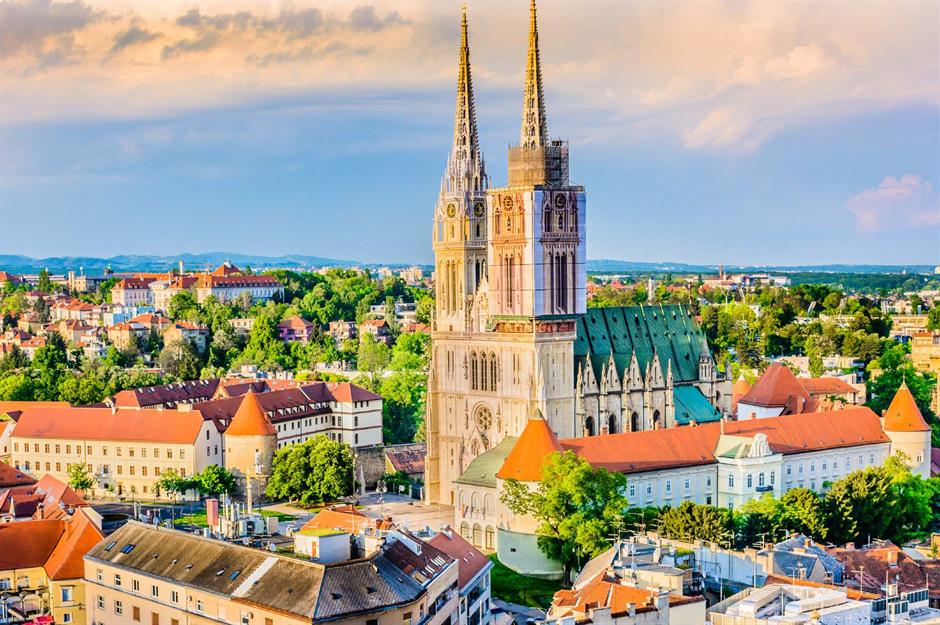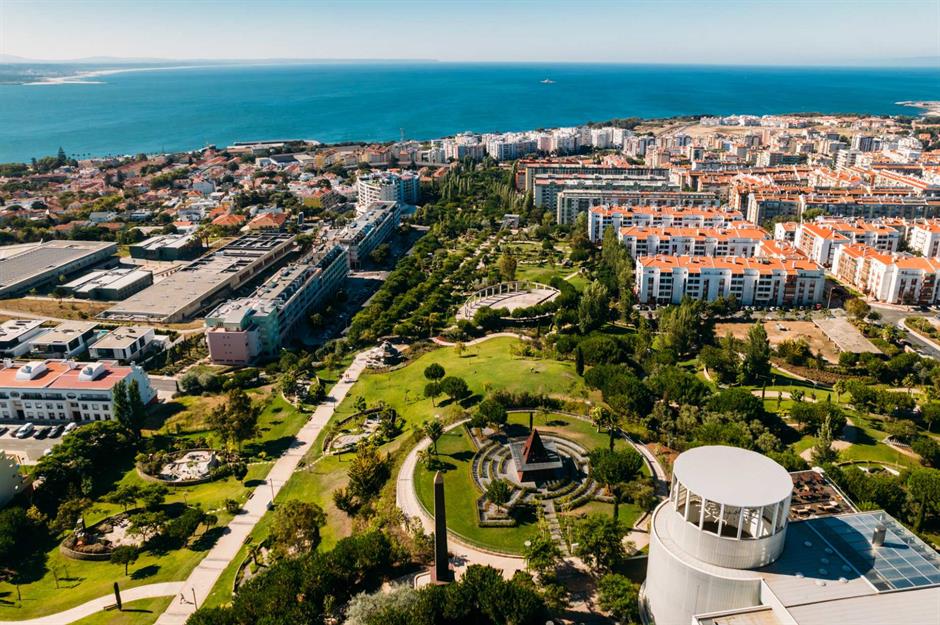Ranked: Europe’s 10 greenest capital cities you need to explore
Havens for nature
While we love the bustle of city life, sometimes you need tranquil spots like parks, gardens and other natural spaces to retreat to. Offering somewhere to take a stroll, have a picnic or even just sit and watch the world go by, these landscapes play a big part in the city life. Equally, having enough trees in an urban area is integral for improving air quality, which has huge benefits for human health. Using data from the European Environment Agency, we reveal the European capitals with the highest percentage of green infrastructure (including parks, trees and other natural features).
10. Lisbon, Portugal
What to see and do
Aside from its gorgeous natural landscapes, Lisbon offers plenty for culture vultures, foodies and history buffs alike. Be sure to visit the lively Feira da Ladra market, which takes place every Tuesday and Saturday at Campo de Santa Clara, as well as checking out the collection of Portuguese artworks at the National Museum of Contemporary Art. Among the top foods to try here are the freshly caught fish and seafood, buttery-sweet pasteis de nata (Portuguese custard tarts) and delicious local wines.
Love this? Follow us on Facebook for more travel inspiration
9. Tallinn, Estonia
Recently named the European Green Capital of the Year 2023, the jewel in Tallinn’s crown is its beautiful Botanical Garden. Occupying 300 acres of land in the east of the city, this gorgeous site comprises immaculate lawns, colourful flower displays and waterlily-filled ponds, plus there are several glasshouses boasting plants from all over the world. The city is 50% covered by green infrastructure, which puts it at ninth in the rankings.
What to see and do
Just wandering the cobbled streets of Tallinn, drifting into little squares and popping into historic churches will keep you busy for hours. It’s well worth walking up to the Kohtuotsa Viewing Platform at the top of Toompea Hill, which offers sweeping vistas across the Old Town, while you should also check out the fascinating Alexander Nevsky Cathedral. As for eating and drinking, the city has a number of craft breweries and restaurants offering everything from fine dining to medieval-style fare.
8. Berlin, Germany
With 51% of its total landscape covered by green infrastructure, Berlin comes in eighth place. And its parks are as diverse and historic as the city itself. There’s the enormous Tiergarten, which is home to pretty lakes and flower gardens, the unusual Tempelhofer Feld, built on the site of an abandoned airport, plus Treptower Park, a grand 207-acre green space which spreads out invitingly along the Spree river.
What to see and do
Don’t miss wandering along sections of the famous Berlin Wall, checking out its stunning murals and snapping a few pictures along the way. Once you’ve toured the main attractions in Mitte (the central district) – the Reichstag Dome, Brandenburg Gate, Checkpoint Charlie et al – head a little further out to discover the city’s other neighbourhoods. Neukölln is home to quirky bars and an international food scene, Kreuzberg has oodles of trendy coffee shops and art galleries, while it’s worth visiting Charlottenburg for the famous Schloss Charlottenburg, a Baroque 17th-century palace set in stunning grounds.
= 6. Bern, Switzerland
With an intriguing mix of buildings dating back as far as the 15th century, alongside stunning views of the River Aare, it’s no wonder Bern’s Old Town is a UNESCO World Heritage Site. But while many visitors come for its architecture and history, they’re pleasantly surprised by how green the city is. In fact with 53% green infrastructure, the Swiss capital is joint-sixth in the EEA rankings. High on any visitor’s list should be Schadau Park, which is home to an enchanting 19th-century castle and has a gorgeous location overlooking the river.
What to see and do
In the labyrinthine streets of the Old Town you’ll find bookshops, coffee shops and plenty of historic attractions, including the famous Clock Tower. Art fans should make a beeline for the Kunstmuseum, which houses a variety of art stretching from the 15th century to modern times, while the Einstein Museum is a must for learning about the famous genius. There are plenty of unique places to stay, including the jazz-themed Unique Hotel Innere Enge, the ultra-luxe and historic Hotel Schweizerhof and Bellevue Palace, the official guesthouse of the Swiss government.
= 6. Madrid, Spain
Joining Bern in sixth place, with 53% of its landscape covered by green infrastructure, is Madrid. The Spanish capital has a number of enticing parks to choose from, the most famous of which is El Retiro, which dates back to the 17th century and boasts a stunning lake, plenty of historic statues and several esteemed art galleries. Elsewhere in the city, you should definitely swing by the Neoclassical Sabatini Gardens and check out the lesser-visited Capricho Park, which is home to English-, French- and Italian-themed gardens.
What to see and do
Fabulous food, plus an exciting arts and culture scene are at your fingertips in Madrid, whose history stretches back almost a millennium. The Golden Triangle alone, which consists of three world-renowned art museums (the Museo del Prado, Reina Sofía and the Thyssen-Bornemisza), could keep you occupied for days. When in need of refreshment, head to Vallehermoso Market for a mix of international and Spanish cuisine, or try the world-famous churros at San Ginés.
5. Vilnius, Lithuania
Anyone who’s visited the Lithuanian capital will know that it’s a verdant oasis, with plenty of parks, forests and trees lining the streets. In fact, green space makes up 57% of the city according to the EEA. One of the best ways to see it in all its glory is to walk up the Hill of Three Crosses, a monument to martyred monks atop a steep hill – just brace yourself for sore legs from the climb. Meanwhile Vingis Park, the city’s largest at 400 acres, is home to botanical gardens, plenty of walking and cycle paths, plus an outdoor concert venue.
What to see and do
Naturally, most visitors will head straight for the Old Town – and rightly so. Dating back to the 14th century, this picturesque part of central Vilnius is a treasure trove of Gothic and Baroque buildings, with many fascinating museums to discover. Don’t miss the Museum of Occupations and Freedom Fights, which details the efforts of those who fought the Soviet regime here during the mid-20th century. As for hotels, Grotthuss is a good base, offering unique decor and a convenient Old Town location.
4. Helsinki, Finland
What to see and do
To take in the city’s lively atmosphere, head to Market Square, where you’ll find vendors selling everything from fresh fish and seafood to artisan jewellery. Meanwhile the Design District is a must-see for arts and culture mavens, Temppeliaukio Church will wow you with its unique circular architecture and the Helsinki City Museum tells the story of the capital's history. Lastly, be sure to check out a sauna while you’re there (and read our article on how to sauna like a Finn).
3. Ljubljana, Slovenia
Named the Green Capital of Europe in 2016, Ljubljana has a reputation for being eco-friendly and that includes lots of lovely outdoor spaces: 67% of the city’s area is covered by greenery, in fact. The crowning glory is Tivoli Park, which covers around 1.9 square miles (5sq km) of Ljubljana. Created in 1813, it has three wide walkways which were built to accommodate horse-and-carriages, plenty of gorgeous flower beds, plus there’s even a popular outdoor gallery in the centre.
What to see and do
Thanks to its compact size and walkable streets, Ljubljana is ideal for a city break. Stroll through its picturesque Old Town, heading across the famous Triple Bridge and peeking into its lively markets and historic cathedrals, before exploring some of its more offbeat attractions. The Museum of Illusions, an interactive space filled with light and mirror installations, is a must-visit. When it’s time to rest, check into the Hotel Cubo, a glamorous Art Deco hotel within easy reach of the city’s main sights.
2. Zagreb, Croatia
You’re never far from nature in Zagreb, which comes in second place with 74% of its landscape covered by green infrastructure. The Croatian capital is home to some amazing parks, including Tuškanac, a small yet wild patch of greenery home to some of the city’s oldest trees, as well as Zrinjevac, which forms part of a larger string of parks across the city centre.
What to see and do
Zagreb actually started out as two separate hilltop towns, Gradec and Kaptol, which remain fairly distinct today. Now, the former is a quaint and charming neighbourhood, laced with pedestrianised cobblestone streets, while the latter is filled with religious buildings, the most famous of which is the majestic-looking Zagreb Cathedral. There’s lots of great food to be found in the city, ranging from traditional Croatian fare to fine-dining and international restaurants.
1. Oslo, Norway
Taking the top spot, Oslo is made up of an impressive 77% green infrastructure – it’s no wonder it was named European Green Capital 2019. The city centre is almost entirely car-free, making it extremely pleasant to navigate on foot or by bike, while plenty of trees and parks mean you’re never far from nature. Vigeland Sculpture Park, located inside Frogner Park, is definitely worth a visit: it’s home to 200 sculptures by the famous Norwegian artist Gustav Vigeland.
What to see and do
Thanks to its fjord-side location, Oslo is well-placed for exploring nearby islands, with Hovedøya and Gressholmen being a short boat ride away. In the capital itself, be sure to pop into the ultra-modern Opera House, visit the Royal Palace, steam it out in a floating sauna and eat sustainable food at VIPPA. There are plenty of chic hotels to choose from, including Amerikalinjen, which has an enviable city-centre location and modern interiors, and the characterful Camillas Hus, which is housed in a 19th-century villa.
Next, discover which European cities have the best walking routes

